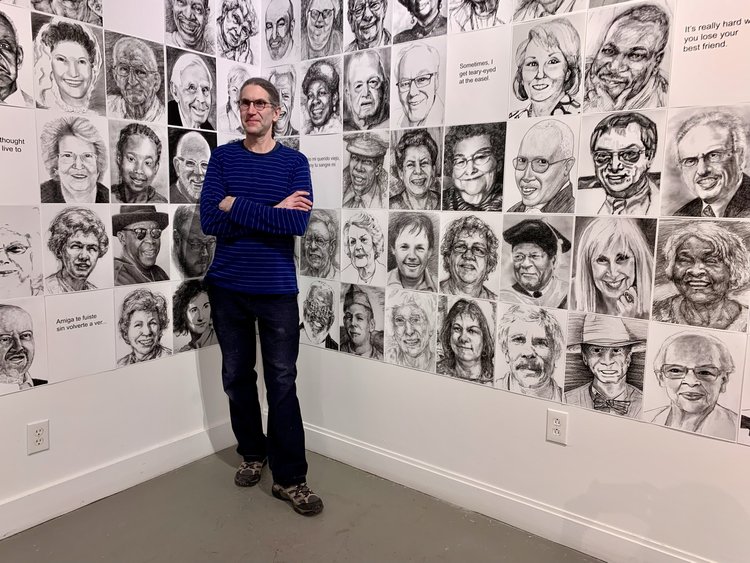
While hundreds of thousands of Americans have lost their lives over the course of the COVID-19 pandemic, the images of some will live on.
Figurative artist RA Friedman was the guest for a Virtual Artist Talk hosted by InLiquid Art + Design, 1400 N. American St., last Thursday evening.
Currently, his work, “The Trouble I’ve Seen: Drawings from the Covid-19 Portrait Project, USA,” is on display through Saturday, March 5.
More than 150 drawn portraits of deceased individuals are on display in the gallery.
The exhibition opened on Feb. 4, with an opening reception on Feb. 10, to purposely mark the two-year anniversary of the pandemic.
Lily Horner, membership coordinator at InLiquid, kicked off the Zoom event, introducing the artist and the curator.
Amie Potsic, curator of the exhibition, provided background on Friedman before introducing him to the virtual audience.
“Adept at photography, drawing and recrafting older technologies, RA’s work melds the human figures’ abilities to convey intimate and complex states of being with the expressiveness of mark making and time-based discovery,” she said.
“RA’s current exhibition seeks to honor and memorialize the thousands of Americans lost to the virus,” she added. “Working from obituary photographs and family provided photographs, RA has gained national attention for drawing portraits of COVID-19 victims as a means of documentation and artistic dialogue.”
Friedman expanded the project to invite other artists to draw portraits to “increase community and collaborativity,” according to Potsic
Potsic provided commentary about working with Friedman.
“In working with RA on this project, I was struck by his compassion, dedication and pursuit of excellence,” she said. “It requires a lot of discipline to go into the studio for hours a day and draw people he’d never met lost to the pandemic. With empathy and honor, he crafted portraits that were intimate, kind and somehow knowing.”
Although Friedman was isolated for a time during the pandemic, he used his work to connect with the world around him, Potsic added.
“It was a wonderful journey working with RA to bring his portraits to light in this memorial exhibition,” she said. “The drawings themselves became the basis for creating an experience that could provide the healing and closure we desperately need.”
Friedman spoke about the emotional impact of creating the portraits.
“It doesn’t really hit you until the portrait is done and it’s looking back at you,” he said. “And then you really start to think about who this person really is, what was going on in their lives, who they left behind. That’s when I start to get teary-eyed. That’s when it gets tough.”
Friedman shared that he wasn’t personally affected much by the pandemic and felt the need to do something.
“I really felt that the perpetual pain I was seeing in the news cycle was touching me, and I felt that that was wrong,” he said. “I felt that I needed to do something, that I needed to make a statement, and that was really why I started drawing.”
Individuals were chosen randomly from a basic Google search, according to Friedman.
When he expanded the project beyond Pennsylvania to nationwide, he would search, “Coronavirus obituary” for each respective state.
“Whoever came up as the first obituary with a photograph, that’s who I used,” Friedman explained.
The portraits in the gallery are transparent.
“Something that happened that was really serendipitous is during daylight, the portraits sort of shimmer and appear and disappear,” Friedman said. “I think it’s a really apt metaphor. You can walk around them and see them from both sides because they’re printed on both sides.”
The exhibition features about 155 portraits.
Other participating artists hail from all over the world, from Florida to Australia, from New York to the United Kingdom.
“It’s just wonderful the energy and goodwill that came forward to create these,” Friedman said. “I could never have done this on my own without the help of them. They continue to produce work. I would love to expand it to 300 when this show, hopefully, moves to New York.”
Friedman is still looking for more artists to participate.
Not only does the exhibition honor those who lost their lives, it allows the living to move forward.
Using community and connection to regain kinship lost during the pandemic, “his work generously offers us an uplifting and positive opportunity for reflection, remembrance and memorial,” Potsic said. ••
The exhibition can be viewed virtually on the Amie Potsic Art Advisory website at amiepotsicartadvisory.com. Gallery visits can also be scheduled on the website. The gallery is open Wednesday through Friday, from noon to 6 p.m., and Saturday, from noon to 5 p.m. For more details about the project, visit rafriedman.com.
